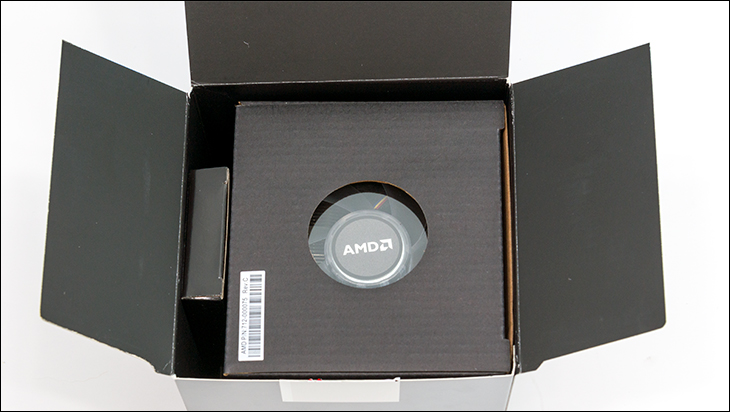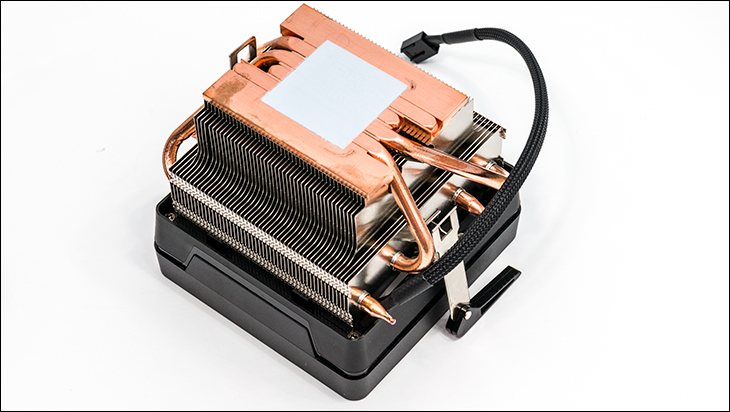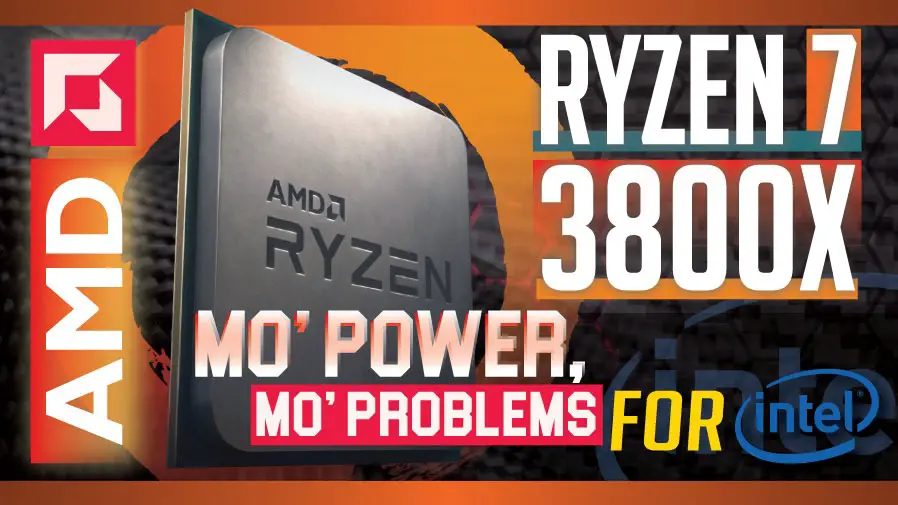
Just as with the Ryzen 5 3600X before the shipping container that AMD has created is both attention getting as well as practical. The color combination will catch your eye when on a store shelf and it tells you precisely what is housed inside. The only minor issue we have with this box is while it be very, very difficult to mistake the Ryzen 7 3800X for another model… it does not actually tell you what a given model means. A simple addition of “8 cores, 16 threads of processing power at up to 4.5GHz” would have made this box perfect. As it stands you will have to know what a Ryzen 7 3800X is before you go shopping. So, “caveat emptor” is in full effect. Make sure you know how many cores/threads/performance you want in your next CPU before picking out an AMD Ryzen box to buy.

Moving on. The internal protection the Ryzen 7 3800X uses is actually different from the lower end models. Instead of plastic inserts to keep everything from slip sliding around (and thus having the included cooler slam into the delicate CPU) AMD has opted for cardboard. Make no mistake, the CPU itself is still in a nice molded plastic tray (just like lower Ryzen 3000-series models) but this tray is then encased in a moderately thick cardboard box. This added layer of protection means that the Ryzen 7 3800X is even more likely to arrive safe and sound than its less expensive models. Color us impressed.

Considering the fact that this is a 105watt TDP CPU it should come as no surprise to see a beefier CPU cooling solution included. Instead of the Wraith Spire cooler, AMD includes their much, much more optimal Wraith Prism RGB cooling solution. What this difference means is that in addition to snazzy RGB LED integration (which can be controlled via most motherboard’s integrated RGB control header… or via AMD software if necessary) the cooler itself is much more robust. This is because instead of being a circular chunk of aluminum cooling solution with moderately sized fan, the Wraith Prism RGB is what was once considered an ‘aftermarket style’ cooler. One with multiple integrated heatpipes. Interestingly enough this newer CPU cooling solution is a HDT (Heatpipe Direct Touch) style cooler where the heatpipes themselves come in direct contact with the CPU’s integrated heatsink and act as the ‘base’ of the cooler.
This does increase efficiency of the cooling solution, but as the heatpipes are thin walled only a certain amount of polishing can be done to them. Basically, at stock settings this cooling solution will allow the CPU to run at better than typical temperatures but since there is no way to spread the load out amongst all the heatpipes… HDT’s tend to run hotter than solid base designs at higher loads. To help overcome this limitation of HDT design AMD has included a copper base which encloses the sides and top of all the heatpipes… and in theory should somewhat help equalize the loads amongst the cores. This in conjunction with a significant amount of cooling fins, sheer mass (this cooling solution tips the scales at 580grams), and a 135mm fan means it can handle TDP loads higher than most aftermarket HDT coolers. While the Wraith Prism RGB’s TDP rating is not specified it is the upgraded version of the original AMD Wraith cooler which had a 125watt TDP rating. As such it is more than up to the task of handling a 105watt CPU… at stock settings.

In testing it was indeed capable of both being very quiet and yet kept the Ryzen 7 3800X temperatures in check at stock levels. It is only when you really start pushing things (e.g. enabling PBO) that it starts to struggle to keep temperatures in check and becomes loud. Though as it is only a 1400RPM fan… ‘loud’ is relative. This is not a loud cooling device. Just one that is not silent when stressed. The downside is that if this had been a 1800RPM fan temperatures would have been much more optimal. As such for a ‘free’ cooler it is rather impressive but if you want to push your shiny new Ryzen 7 3800X hard we would still recommend an after-market cooling solution for optimal temperature and noise levels. To be fair, Intel’s comparably priced Core i7-9700K does not even come with a basic cooler. The very fact AMD includes an actually decent solution makes Intel look downright miserly in comparison.

Speaking of the Core i7-9700K, as these two processors are priced within dollars of each other, it is the main competitor for AMD’s Ryzen 7 3800X so it does behoove us to compare and contrast them. The intel 9700K is an eight core, eight thread processor which comes equipped with 384KB of L1 cache (total), 1.5MB of L2, and 9MB of L3. This is noticeably less than the 512KB (total) of L1, 4MB of L2, and whopping 32MB of L3 cache the AMD Ryzen 7 3800X boasts. In heavy applications this additional cache will make the Ryzen 7 3800X more efficient and increase its actual IPS rating. Counteracting this IPS improvement, and making it all but moot, is the Intel is clocked much higher with a base of 4.0Ghz (instead of 3.9GHz) and has a maximum boost frequency of 5.0Ghz (instead of 4.5Gh). To further muddy the waters AMD comes with SMT for a total of 16 threads of processing power… but Intel lacks ‘HyperThreading’ (Intel’s version of SMT). Also noteworthy is while Intel’s option may have a 5.0Ghz rating its real max all core speed is 4.6Ghz. AMD’s all core max is more… amorphous as it is more temperature bottlenecked than anything. Most cases you can consider it to be in the 4.0-4.3Ghz ‘all core’ range.
The Intel Core i7-9700K is also a monolithic core design, whereas AMD is a Multi-Chip Module design which relies upon ‘chiplets’. In the Ryzen 7 3800X’s case this is one fully enabled CCD chiplet consisting of two CCXs (with four cores per CCX) and one cIOd chiplet for everything not directly number crunching related. Since AMD’s design relies upon Infinity Fabric 2 to push data from the cores to the cIOD it does have a low-level bottleneck ‘built in’. One that has a higher latency penalty compared to Intel’s Mesh interconnect setup.
The other issue is that AMD Ryzen 3000-series is designed around two CCDs and one cIOD chiplet… not 1+1 as used in the Ryzen 7 3800X. As such with only one CCD and a missing / empty zone on the die means there is going to be a hot spot on the IHS. One that is offset in both X and Y dimensions. For the average buyer this will not matter but the included cooling solution is HDT based and as such at least one heat pipe will have to rely upon the Integrated Heat Spreader to transfer heat to a zone it can actively work at moving heat away from the CPU.
What does all this mean? It means that both have their own unique strengths and weaknesses. For heavy loads AMD will most likely out muscle the 9700K but at lower loads (i.e. less cores active and working on a problem at a given time) Intel will edge ahead. For overclocking enthusiasts, the more mature Intel design can clock higher with fewer headaches. In either case it is a true horserace. This is the first time in a long time that AMD and Intel are head to head competitors with no real major advantage for Intel rely upon to help boost sales. Instead both companies have to show where they are strong in and hope that aligns with you the average consumer’s needs/wants/desires.











